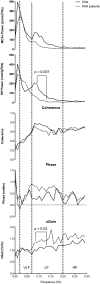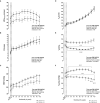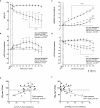Compromised Cerebrovascular Regulation and Cerebral Oxygenation in Pulmonary Arterial Hypertension
- PMID: 29025748
- PMCID: PMC5721836
- DOI: 10.1161/JAHA.117.006126
Compromised Cerebrovascular Regulation and Cerebral Oxygenation in Pulmonary Arterial Hypertension
Abstract
Background: Functional cerebrovascular regulatory mechanisms are important for maintaining constant cerebral blood flow and oxygen supply in heathy individuals and are altered in heart failure. We aim to examine whether pulmonary arterial hypertension (PAH) is associated with abnormal cerebrovascular regulation and lower cerebral oxygenation and their physiological and clinical consequences.
Methods and results: Resting mean flow velocity in the middle cerebral artery mean flow velocity in the middle cerebral artery (MCAvmean); transcranial Doppler), cerebral pressure-flow relationship (assessed at rest and during squat-stand maneuvers; analyzed using transfer function analysis), cerebrovascular reactivity to CO2, and central chemoreflex were assessed in 11 patients with PAH and 11 matched healthy controls. Both groups also completed an incremental ramp exercise protocol until exhaustion, during which MCAvmean, mean arterial pressure, cardiac output (photoplethysmography), end-tidal partial pressure of CO2, and cerebral oxygenation (near-infrared spectroscopy) were measured. Patients were characterized by a significant decrease in resting MCAvmean (P<0.01) and higher transfer function gain at rest and during squat-stand maneuvers (both P<0.05). Cerebrovascular reactivity to CO2 was reduced (P=0.03), whereas central chemoreceptor sensitivity was increased in PAH (P<0.01), the latter correlating with increased resting ventilation (R2=0.47; P<0.05) and the exercise ventilation/CO2 production slope (V˙E/V˙CO2 slope; R2=0.62; P<0.05) during exercise for patients. Exercise-induced increases in MCAvmean were limited in PAH (P<0.05). Reduced MCAvmean contributed to impaired cerebral oxygen delivery and oxygenation (both P<0.05), the latter correlating with exercise capacity in patients with PAH (R2=0.52; P=0.01).
Conclusions: These findings provide comprehensive evidence for physiologically and clinically relevant impairments in cerebral hemodynamic regulation and oxygenation in PAH.
Keywords: central chemoreceptor sensitivity; cerebral ischemia; cerebral oxygenation; cerebrovascular reactivity to CO2; exercise physiology.
© 2017 The Authors. Published on behalf of the American Heart Association, Inc., by Wiley.
Figures






References
-
- Galiè N, Humbert M, Vachiery JL, Gibbs S, Lang I, Torbicki A, Simonneau G, Peacock A, Vonk‐Noordegraaf A, Beghetti M, Ghofrani A, Gomez‐Sanchez MA, Hansmann G, Klepetko W, Lancellotti P, Matucci M, McDonagh T, Piérard LA, Trindade PT, Zompatori M, Hoeper M. 2015 ESC/ERS guidelines for the diagnosis and treatment of pulmonary hypertension: the Joint Task Force for the Diagnosis and Treatment of Pulmonary Hypertension of the European Society of Cardiology and the European Respiratory Society. Eur Respir J. 2015;46:903–975. - PubMed
-
- Lajoie AC, Lauzière G, Lega JC, Lacasse Y, Martin S, Simard S, Bonnet S, Provencher S. Combination therapy versus monotherapy for pulmonary arterial hypertension: a meta‐analysis. Lancet Respir Med. 2016;4:291–305. - PubMed
-
- Rival G, Lacasse Y, Martin S, Bonnet S, Provencher S. Effect of pulmonary arterial hypertension‐specific therapies on health‐related quality of life. Chest. 2014;146:686–708. - PubMed
-
- Benza RL, Miller DP, Barst RJ, Badesch DB, Frost AE, McGoon MD. An evaluation of long‐term survival from time of diagnosis in pulmonary arterial hypertension from reveal. Chest. 2012;142:448–456. - PubMed
MeSH terms
Substances
LinkOut - more resources
Full Text Sources
Other Literature Sources
Medical
Molecular Biology Databases

